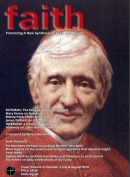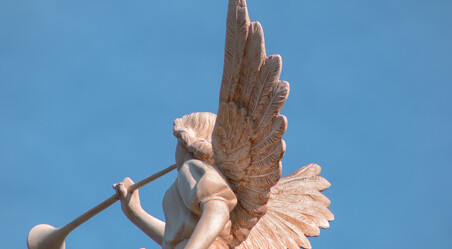Book Reviews
FAITH Magazine May-June 2005
Adrian Read enjoys some thought provoking speculation into the cosmic working of prayer and the Rosary in particular; Chris Massey recommends a Catholic teaching on marriage for the young.
The Rosary in Space and Time
by Ruth Rees Gracewing, 140pp, £7.99
An intriguing title, this. Specifically, the words space and time refer to the time and place in which Mary and Jesus lived. As a Jewish convert, Ruth Rees came to the Faith, and to the Rosary in particular, with a lot of unanswered questions relating to her cultural and religious heritage. For example, what would it have been like for the Holy Family living in Roman-occupied Judea in the first century AD? How would Mary have travelled to visit Elizabeth ? What traditional Jewish mourning customs would have been observed after the death of Jesus? Her quest for a deeper understanding of the day-to-day lives of Jesus and his disciples led her to realise that “it is impossible to experience the profundity of the Rosary – and pray it well and lovingly – without a close attachment to itsoriginal source: the New Testament.” This book, or rather the second half of it, is a result of that quest. There’s a chapter for each mystery, including the mysteries of light. But first comes an illuminating discussion of prayer in which she makes the striking observation that our petitions can encompass the past and future as well as the present. “For instance, we have it within our spiritual power to pray for those who were martyred for the Faith in past centuries, so that their pain may have been lessened at the hour of their greatest suffering.” I’d be interested to know what other readers make of this.
The deeper significance of the title becomes clear when Rees explores the inter-connectedness of all creation. She does this, rather unusually, by linking the transcendent power of prayer with the principles of chaos theory and sub-atomic physics. I wasn’t altogether convinced. For example, in quantum physics the act of observing a particle affects the result of the observation (as she points out), but I don’t see the similarity between making such an observation and praying for a particular intention. When we pray for someone, we begin with the assumption that they exist. For many physicists, though, there’s no such thing as objective reality at the quantum level: a particle can’t be said to exist until it’s measured.
She also uses the famous ‘butterfly effect’, in which the flapping of a butterfly’s wings can trigger a series of reactions that produce a hurricane thousands of miles away, to illustrate the way in which our seemingly insignificant prayers can achieve great things if offered in love. I liked this analogy better, though we have to remember that the physical world (at the macro level at least) is still a deterministic system, however chaotic it appears to be, while the world of prayer most certainly isn’t.
More interestingly, perhaps, for readers of FAITH, is her description of Christ as “our spiritual unified field”. The quest for a unified field theory, which would unite the four fundamental forces of matter in a single set of equations, is the Holy Grail of modern physics. Christ, though, is not a distant goal that may never be achieved, but “the complete answer to the deepest longings of the human soul.” In FAITH we would go one further and say that Christ is the source and summit of the whole of creation, the master key to the meaning of the universe. Rees ends her ‘cosmic’ odyssey by pondering the remarkable similarity between Stephen Hawking’s thesis in his book The Universe in a Nutshell and the revelations given in 1373 to the great English mystic Dame Julian of Norwich . “Heshowed me a little thing, the size of a hazelnut,” wrote Dame Julian. “I looked upon it with the eye of my understanding, and thought, What may this be? I was answered in a general way, thus: ‘It is all that is made.’” It took some 700 years for scientists to reach the same understanding. The difference is that God made it clear to Dame Julian that creation is an act of love, not of necessity. In her final chapter, Rees asks what it would mean, theologically, if intelligent life were to be found in other solar systems. We should be overjoyed, she says, at this proof of God’s glory in the immensity of his creation. She leaves us with a rather inspiring piece of speculation: “It was from an obscure region of a relatively unimportant part of the Middle East that Our Lord sent his disciplesto preach his Gospel throughout the world. Is it not possible that God may have chosen our insignificant little planet, located on the outer rim of a huge galaxy, to be the Galilee of the cosmos?” Ruth Rees deserves credit for writing such a stimulating, thought-provoking book. Short and simply written, it’s an ideal gift for anyone seeking to enter more deeply into the mysteries of the Rosary.
Adrian Read
Honor Oak Park
London
Marriage & Gift: a Catholic Perspective
by Josephine Robinson, St Pauls, 208pp, £8.95
Modern society is often deemed to be obsessed with many things. Love, power, sex, and greed, are just some of the subjects that are constantly in the media. Far less so these days do we hear about things that once were the bedrock of everyday life, namely trust, respect, humility, and of course marriage. The writer of this book, Josephine Robinson, has therefore decided to write a guidebook for modern marriage, from a Catholic perspective. Marriage & Gift, takes the reader through the steps that lead up to that sacrament, and then follows on with advice about the many facets of marriage, from children, to potential marital problems. She quotes from the teachings of the Catholic Church, such as Gaudium et Spes, on a whole range of issues from the sacramental nature of marriage to theimportance of the being open to new life. Her primary intention is to give practical advice to those who are about to get married, newlyweds or those who simply wish to learn more about marriage. I am in the middle category, and so I read her book with considerable interest. The author is the mother of three children, was been educated at Oxford and the Open University. She has worked as a volunteer for several charities, and is currently chairman of the Association of Catholic Women. The result of her varied background is that she has a wide range of sources upon which to call. She quotes, either from her own experience or that of her friends, a substantial amount of advice that she wishes to pass on. We learn, for example, of the importance of including grandmothers in the raising ofchildren. “New mothers should not be afraid of asking their mother, or mother-in-law, to look after the baby if they live fairly near.” When the author refers to other commentators on specialist subjects, such as the raising of children, she is quite precise in how she mentions them, and also from where their observations, or research, have originated. Not only does Robinson quote from Jane Feinmann's Baby Blues, for example, but she also provides an endnote from which the book can be traced. When dealing with such writers, Robinson is concise, easy to follow, and provides a good source of further information. However, the same cannot be said for the whole of the book. I found the opening chapter, which is concerned with preparation for marriage, to be rudimentary. Its style is differentfrom that of some of the later chapters, and is largely anecdotal. At one point in this chapter, she mentions that a child is less likely to run away from home if he or she has two parents who are married to each other. Given the number of children who have done that, whilst having those parents appeal on television for them to come home, I feel that she has taken too much of a simplistic approach to some areas. Although this book is always easy to read, it is worryingly generalistic. On page 87, she informs us that “one of the most noticeable of women's abilities is that of building bridges.” Although I am aware that there are, perhaps, more peace-makers amongst women than men, I am also aware of plenty of men, who do seek to get on with their fellow human beings, and somewomen who do not! The most interesting part of the book for myself was the discussion on the different types of love, as based upon the Greek model. The author therefore describes all four different types, from eros, or sexual and physical love, to agape, or the love which involves complete self-giving. In this chapter the author thus sets the nature of love in context, and goes on to point out that a marriage must be able to embrace all four of the different types, in order to be able to last, and ultimately prosper. This part of the book is very good and also the later sections on the difficulties that a marriage can face, and the reassurance that the examples of the married saints can offer. For the young and any who do not have a reasonable grasp of the faith this book could bebeneficial.
Chris Massey
Kirkham
Preston






